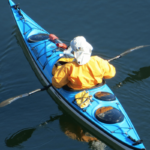A kayak pool is a unique type of pool specifically designed to simulate the conditions needed for kayaking. Unlike regular swimming pools, kayak pools create a controlled environment where paddlers can practice their skills, whether it’s for fitness, fun, or training. These pools offer a steady water flow, allowing users to simulate the experience of kayaking on open water. If you’re interested in other types of kayaking, check out this article on how fun kayaking can be. With the increasing popularity of outdoor water sports, kayak pools have become an excellent option for those who want to hone their kayaking techniques without needing a river or a lake nearby.
If you’re wondering what is a kayak pool, it is essentially a compact pool with features that make it suitable for practicing kayaking. Unlike traditional pools, a kayak pool is designed to provide both the space and current required for real kayaking training. It uses various systems to generate water flow, giving users the sensation of paddling in moving water. Kayak pools are built for enthusiasts who want to practice in any location, whether it’s in their backyard or inside a facility.
In addition to providing a space for training, kayak pools are ideal for those who enjoy the thrill of kayaking but don’t have easy access to rivers or lakes. These pools offer a safe, private, and convenient way to engage in the sport all year round. They come in various sizes, from small backyard setups to larger, more professional installations. Their customizable nature means that users can adjust the flow of water to match their skill level and training needs.
How Kayak Pools Work
A kayak pool works by creating a controlled water environment that simulates the experience of paddling in open water. This is achieved through the use of specialized systems that generate consistent water flow, allowing the paddler to practice various kayaking maneuvers without ever needing to leave the pool. The flow is adjustable, so it can be modified to suit different skill levels, from beginners to advanced kayakers.
It’s important to understand the mechanics behind these unique pools. Unlike traditional swimming pools, kayak pools feature a current-generating system that keeps the water moving. The water flow is created using pumps, which circulate the water through the pool and push it in a specific direction. Some kayak pools even have a built-in feature to adjust the speed of the flow, giving users more control over their training environment.
In addition to generating a current, kayak pools are designed to maintain a constant depth, which is essential for a realistic kayaking experience. The water level is typically kept at a specific height, ensuring that the kayaker can practice balancing, paddling, and even performing tricks without worrying about hitting the bottom of the pool. This setup is perfect for both recreational paddlers and those training for competitions.
Key features of kayak pools:
- Adjustable water flow
- Compact design
- Customizable sizes
- Consistent depth
- Easy installation
- Low-maintenance design
These features make kayak pools a versatile solution for those looking to practice kayaking in a controlled and convenient setting. Whether you’re preparing for a kayaking race or just enjoying the sport as a hobby, a kayak pool provides everything you need to improve your skills.
Benefits of Owning a Kayak Pool
Owning a kayak pool offers numerous advantages, especially for those passionate about kayaking or watersports in general. One of the main benefits is convenience. With a kayak pool in your backyard, you can train and practice at any time, without needing to travel to a river, lake, or other bodies of water. This makes it much easier to stay consistent with training and improve your skills in a controlled, familiar environment.
Another significant benefit is the versatility of kayak pools. These pools can be used not only for kayaking but also for other aquatic activities such as swimming, relaxation, and even aquatic fitness exercises. Their adjustable water flow also makes them suitable for various skill levels, from beginners who need a slower current to more experienced kayakers looking for a faster, stronger flow to practice advanced techniques.
If you’re still wondering what is a kayak pool and why you should consider owning one, the cost-effectiveness of maintaining a kayak pool compared to traditional kayaks is another factor to consider. While a kayak pool requires an initial investment, the long-term benefits are substantial. There are no worries about transport, rental fees, or the maintenance of traditional kayaks, making it a one-time purchase for years of enjoyment.
Additionally, kayak pools are eco-friendly alternatives to other forms of water training. They use less water and energy than large-scale pools or water systems, and their compact design ensures that they fit into smaller spaces, making them ideal for suburban or urban homes.
The cost of installing a kayak pool can vary depending on several factors, including the size, features, and installation location. On average, the price of a kayak pool ranges from a few thousand dollars for a small, basic model to tens of thousands for a larger, more advanced system. While this price may seem high, it’s important to consider the long-term benefits and savings associated with having a kayak pool.
It’s worth noting that the cost reflects its specialized design and functionality. Unlike traditional pools, kayak pools are built with specific features such as water flow systems and reinforced structures to handle the demands of kayaking. These factors contribute to the higher upfront costs.
Estimated cost breakdown for installing a kayak pool:
| Item | Estimated Cost Range |
| Pool Installation | $5,000 – $20,000 |
| Water Flow System | $2,000 – $10,000 |
| Additional Features | $1,000 – $5,000 |
| Maintenance (per year) | $500 – $1,500 |
| Custom Design Options | $1,000 – $8,000 |
In addition to the purchase price, there are other costs to consider, such as installation, ongoing maintenance, and any upgrades you might want to add. While kayak pools are generally low-maintenance compared to regular pools, they still require periodic care, such as cleaning the water circulation system and checking for any wear on the components.
After reviewing the cost structure, it becomes clear that while the initial investment can be significant, the long-term benefits—such as the ability to train year-round and the low maintenance requirements—make kayak pools a valuable addition to your home or facility.
Maintenance and Care of Kayak Pools
Maintaining a kayak pool is relatively straightforward, but like any specialized pool, it requires regular care to ensure optimal performance. One of the key aspects of maintenance is keeping the water clean and clear. This is typically achieved through filtration systems that continuously clean the water and keep it free from debris. Regular checks on the water flow system are also essential to ensure that the current is functioning properly and remains adjustable as needed.
For those considering what is a kayak pool, understanding its maintenance needs is crucial before installation. Kayak pools have specific components that need attention, such as the pumps, filters, and the current-generating system. These systems need to be cleaned and serviced regularly to maintain the pool’s efficiency. Fortunately, many kayak pool manufacturers offer maintenance packages, which can help reduce the complexity of upkeep for pool owners.
In addition to the mechanical aspects, the physical condition of the pool should be inspected periodically. The pool’s surface, whether it’s fiberglass or vinyl, should be checked for cracks or wear. Additionally, it’s essential to monitor the water quality, which involves maintaining the proper chemical balance to ensure a safe and pleasant experience for users.
Kayak Pool Installation Process
The installation of a kayak pool is a process that involves several key steps to ensure that the pool functions as intended. Unlike traditional pools, kayak pools require specialized equipment to generate water flow and to create the right conditions for kayaking. The installation begins with a thorough assessment of the space where the pool will be placed. The size of the area and the availability of water and power sources will determine which kayak pool model is best suited for the location.
Once the site is prepared, the installation team will begin the construction of the pool, including setting up the water circulation system. This system is crucial because it creates the current needed for kayaking. After the structure of the pool is completed, the current-generating system is installed and tested to ensure it works properly. The last step is to fill the pool with water and test all features, including the adjustable water flow and filtration system.
Key steps in installing a kayak pool:
- Assessing the available space and determining the ideal pool size.
- Setting up the water circulation system.
- Installing the current-generating system.
- Filling the pool with water and testing the system.
- Final inspection and quality check.
The installation of a kayak pool can take anywhere from a few days to a few weeks, depending on the complexity of the system and the size of the pool. It’s also important to note that professional installation is highly recommended, as the setup of the water flow system requires specialized knowledge. After installation, regular maintenance and care are essential to ensure the longevity and efficiency of the kayak pool.
Conclusion
In conclusion, what is a kayak pool is not just a question about its functionality, but also about the exciting potential it offers to kayakers and water sport enthusiasts. Kayak pools are revolutionizing how people approach kayaking training and leisure activities. Whether you’re looking to practice your skills in a controlled environment, maintain fitness, or simply enjoy the thrill of kayaking without the need for open water, a kayak pool offers a solution that traditional swimming pools simply cannot match.
For kayakers, these pools offer the perfect setting for training throughout the year. No longer do you need to wait for the right weather conditions or travel long distances to a river or lake. Kayak pools provide a consistent, customizable water flow, allowing you to practice in various conditions, whether you’re working on basic strokes or advanced maneuvers. Moreover, they are also a great option for those who live in urban or suburban areas where natural water bodies are scarce. With the compact nature of many kayak pools, they can be installed in backyards, commercial spaces, or indoor facilities, making them accessible to more people than ever before.
Beyond their practical use for training, kayak pools offer a range of benefits that enhance their appeal. These pools are designed with durability in mind, requiring less maintenance than traditional pools, which often need regular chemical treatments and cleaning. The adjustable water flow system is easy to maintain and can be modified to suit different training needs. Furthermore, kayak pools provide a safe and private space for water sports enthusiasts, reducing the risk associated with outdoor training in unpredictable conditions. They also offer a fantastic social space, where friends and family can gather to enjoy water activities in a safe and enjoyable setting.





